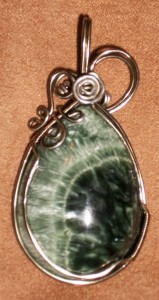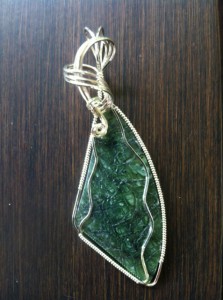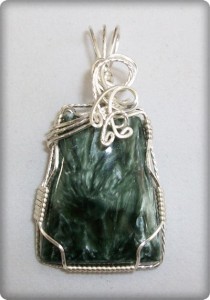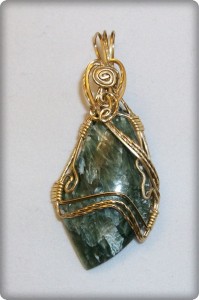- NEW DVD Series – Stone Setting with Bezels
- Tube Set Charm by Kim St. Jean
- Prong Basket Pendant by Kim St. Jean
- NEW DVD Series – Stone Setting with Cold Connections
- New DVD Series – Stone Setting with Wire
- NEW DVD Series: Introduction to Stone Setting by Kim St. Jean
- Featured Tool: Bracelet Bending Plier
- NEW Dvd by Eva Sherman
- Fun, Fast Fold Forming DVD Series
- Double Band Ear Cuff from Alex Simkin
Gem Profile: What is Seraphinite?
by Layna Palmer, Wire-Sculpture.com

Seraphinite
I like baking. I like taking different ingredients, especially chocolate, mixing them all together, subjecting it to heat and coming up with something wonderful in the end. Rocks are a lot like baking, and often a lot more interesting than people give them credit for. I love the idea of taking several different minerals, mixing them together, applying water, heat or pressure (sometimes all three) and coming up with something entirely different.
This week we’re mixing Magnesium, Iron, Aluminum and Silicon, subjecting them to some heated water, and coming up with Clinochlore which is more commonly known as Seraphinite (suh-raff-en-ite).
About Seraphinite
Seraphinite is a beautiful green stone interspersed with chatoyant threads of mica reminiscent of wings. Seraphinite has a vitreous, or glass-like, luster with basal cleavage and is part of the Chlorite group of minerals. The Chlorite group consists of mostly green minerals with seraphinite being one of its only stars; the other is the bright lavender Kaemmererite.
Seraphinite gets its name from the reference in the book of Isaiah in the Bible with mentions of Seraphs or Seraphim, six-winged fiery beings sometimes thought of as snake- or dragon-like, surrounding the throne of God. If you look at a cut piece of Seraphinite, you can almost see wings in the pattern of the stone.

Shawnea Hardesty created this seraphinite pendant using gun metal enameled wire and a green seraphinite cabochon with a dramatic crystal structure.
How Seraphinite was Discovered
Seraphinite, or Clinochlore, was first identified in 1851 in West Chester Pennsylvania, though Russian mineralogist Nikolay Koksharov is often given credit for actually discovering the stone. Seraphinite is usually forest green to gray in color and has a hardness of 2-3 on the Mohs scale. Since the stone is so soft, usually only beads or small cabochons are used in jewelry settings. If you do use a larger piece of Seraphinite in a setting, use a bezel or similar setting to protect the stone from breaking if it’s bumped or dropped.

Barbara Preston wrapped this seraphinite cabochon in sterling silver wire, for a pendant measuring 3″x 1.25″
Metaphysical Seraphinite Properties
Because of the wing-like inclusions, seraphinite is a healing stone, helping detoxify and strengthen the body. It also aids in weight loss by stimulating the metabolism and can help relieve muscle tension. In addition to physical healing, seraphinite can help release emotional pain and bring enlightenment and balance to the psyche. Placed in the south or southeast areas of a home or room, seraphinite can bring health, financial prosperity, vitality and supports new beginnings in life.
Where is Seraphinite Found?
Road Trip! Though most of the seraphinite on the market today comes to us from the Lake Baikal region of Russia, it has some notable locales in the United States. One of the first recorded finds of seraphinite was in Britton’s Quarry West Chester Pennsylvania. The quarry was originally opened in 1730 with the stones from the quarry used as building material for the many farm houses in the area and several buildings at the University of Pennsylvania among other areas. There are currently no mining operations within the quarry, because two of the three holes are filled with water. The third hole has been opened at times for rock-hounding, but check locally before heading to the quarry to make sure it’s open.
There are some wonderful sights around the West Chester area. Marsh Creek State Park offers up sailing lessons, camping and outdoor adventure for the family, and Philadelphia breathes the birth of our nation with beautiful buildings steeped in history.
Other areas where Seraphinite has been found in North America are the Diablo Mountains of California; Trumbull, Connecticut and the Jeffrey Mine in Quebec, Canada. Though none of these areas offers public access to my knowledge, I’m pretty sure there are plenty of activities and places to visit in the surrounding areas and who knows, maybe you’ll find discover some beautiful Seraphinite in some little obscure rock shop while adventuring on your own road trip!
Well, we’ve talked about one rock named for its resemblance to fiery, winged, possibly serpent-like beings, which reminded me of another rock named for its resemblance to serpents that we’ll explore next week.
Have you made wire jewelry with serpentine before? Send us pictures at tips@wire-sculpture.com and they could be featured!
Resources & Recommended Reading
- Clinochlore
- Marsh Creek Lake
- The American Mineralogist: Minerals of Brinton’s Quarry, Chester County, PA (348KB download)
- Seraphinite on CrystalVaults
- Seraphinite on Wikipedia
- Seraphinite on GemDat.org
Gem Profile by Layna Palmer
Click to Receive Daily Tips by Email
























june postnikoff
May 19, 2013 at 11:23 am
Is it okay to put this stone in a tumbler in the rough form?
Would you add ceramic or is the stone too soft?
Rose
May 20, 2013 at 7:25 am
Hi June,
Because Seraphinite is only a 2-4 on Moh’s Scale, I’d keep it out of a steel shot tumbler, but maybe it would be ok with plastic pellets or rice. I’d try a bead through it first, though, before you send a cab or a finished piece, though!
And I wouldn’t know about tumbling rough, does anyone have any suggestions for June?
-Rose